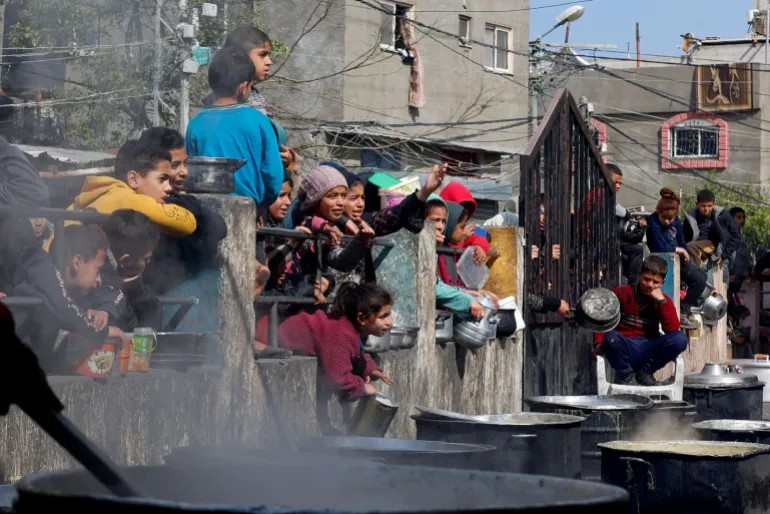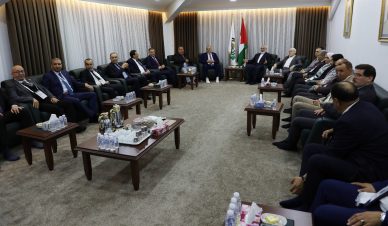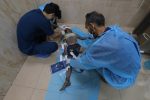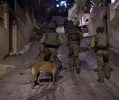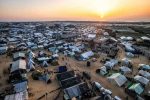GAZA, (PIC)
Has death by starvation become a familiar occurrence? With this question, Palestinian Osama Hameed began his discussion about the facts of the famine striking the Gaza Strip and its northern regions, due to the criminal acts of Israel, amidst the silence and incapacity of the entire world.
Hameed told the Palestinian Information Center’s correspondent: “Here in northern Gaza, people die daily, especially children and the elderly, from hunger. Yes, from hunger and the absence of any food. No one knows anything about them because there is no media coverage and no organizations documenting these events.”
After 140 days of the start of the Israeli bloody war on the Gaza Strip, and the tightening of the blockade on Gaza and its northern regions, and the prevention of any aid from entering, levels of hunger and famine reached a terrifying level.
Hameed explained: “Even animal fodder has run out. Here, we barely get a limited meal every two or three days. We rely on herbs, grasses, and mixing contaminated water with salt.”
Until safe conditions are available
Amidst this suffocating crisis, the World Food Program announced, in a tweet on its official account on the “X” platform on Tuesday, February 20, 2024, the suspension of humanitarian aid entry into the besieged northern Gaza Strip, after only 3 days of attempts to resume it, citing “pending the availability of safe conditions.”
This followed a complete cessation of all types of aid for a period of 3 weeks after the Israeli occupation army bombed a relief aid truck on the coastal road southwest of Gaza City before entering the besieged area.
The statement by the World Food Program coincides with statements on the same day by UNICEF, which said that the death threatens 600,000 children in Rafah, south of the Gaza Strip, living without food or medicine and in extremely dangerous conditions in the city’s camps.
Between the north and the south, dark contours emerge, outlining the fate of hundreds of thousands threatened by the danger of famine, squeezed by hunger and the lack of food supplies in the Gaza Strip, which has been under Israeli aggression since October 7 of last year.
How did the famine begin?
The famine began 48 hours after the start of the Israeli aggression on Gaza, when Israeli War Minister Yoaav Galant announced his decision to prevent “food, water, and fuel from entering the enclave.” This official decision signaled the use of starvation as a weapon of war, violating international law from the outset.
Israeli forces closed all crossings with the Gaza Strip, through which 600 trucks entered daily via the Kerem Shalom crossing. Humanitarian aid that flowed to the Egyptian airport in El-Arish remained detained for a full 15 days before an American-Egyptian-Israeli agreement was reached to allow limited entry, meeting only 1% of the Strip’s needs under normal circumstances.
The Israeli army began its ground invasion of northern Gaza on October 27, 2023, after allowing regulated entry of aid for a few days, limited to Khan Yunis in the south of the Gaza Strip.
The occupation forces divided the Gaza and North Gaza governorates from the central governorate by cutting off Salah al-Din Street and advancing towards the coastal Rashid Street in the west to tighten the siege on Gaza City and the northern cities. The same applied to the south, which faced similar ground advances.
International organizations hurried to withdraw from northern Gaza amid Israeli eviction orders targeting Gaza and its north, leaving over 1.5 million citizens under the control of the Israeli war machine.
Under threat and bombardment, hundreds of thousands fled to the south, but around 700,000 Palestinians remained in Gaza and its north, refusing the idea of displacement.
Food supplies began to run out gradually as the north was besieged from all four corners, with the continued prevention of any aid entry and the deliberate destruction of residential neighborhoods, markets, stores, and bakeries. Citizens faced immense difficulties in compensating for the lacking supplies.
In the first few weeks, the north of the Gaza Strip exhausted its stockpiles of food in houses and shops, and residents resorted to searching destroyed or abandoned houses for canned goods.
Some residents recount how they were forced to remove the doors of abandoned shops to find food for themselves and their families after their own supplies ran out.
According to a report published by Al Jazeera, the signs of famine began to appear among the remaining population of the northern Gaza Strip, with Israeli insistence on preventing any food aid entry amid waves of intense airstrikes and fierce ground confrontations with the resistance.
In the south of the Gaza Strip and the central area, living conditions remained relatively better than the north, with limited aid trucks entering. However, the influx of hundreds of thousands of displaced persons from the north exerted pressure on the stock of food supplies in these areas, increasing the need for larger amounts of humanitarian aid that remained inadequate. Prices skyrocketed to levels that most families couldn’t afford.
The Gaza Strip became two
At the beginning of December last year, the occupation army launched its ground operation to invade the city of Khan Yunis in the southern Gaza Strip, resulting in the displacement of hundreds of thousands of its residents mainly towards Rafah and to a lesser extent towards the central camp areas. Consequently, the Gaza Strip turned into three population blocks: Rafah, Central, and North.
Three full months into the aggression, the separation of the north from its center and south persisted. As the battles reached the heart of Khan Yunis city, Rafah remained connected to the central area via the coastal road, which was subject to attacks by land, sea, and air.
Northern Gaza remains under strict siege, estimated to be inhabited by about 700,000 citizens, entirely deprived of any food support or access to humanitarian aid, which was completely cut off according to a statement by the World Food Program.
In the south of the Gaza Strip, humanitarian aid trucks continue to enter intermittently, contributing to the provision of canned goods and flour in quantities insufficient to meet the needs of more than 1.6 million inhabitants residing in Rafah and the central governorate.
Hunger as a weapon
The UN Special Rapporteur on the Right to Food, Michael Fakhri, affirmed that Israel is using hunger as a weapon to harm and kill civilians in Gaza. This echoes the findings of a December report by Human Rights Watch, which stated that the Israeli government “uses civilian starvation as a war tactic in the Gaza Strip, constituting a war crime.”
The report served as legal evidence of the new blockade pattern that Israel imposed on the Gaza Strip. Observers note the continued exacerbation of famine in the north.
Traps for murder
The siege on northern Gaza took on a new form beyond the prevention of humanitarian aid entry. It extended to redirecting the few trucks allowed access to become traps for sniping and assassination of civilians who gathered to await truck arrivals and aid distribution.
The occupation forces directly targeted the aid trucks heading to the besieged north, leading to decisions to stop aid shipments to the area, as announced by the World Food Program.
Journalists’ cameras in Gaza City documented dozens of video clips showing citizens being targeted by gunfire from tanks, drones, and even naval vessels, resulting in casualties and injuries in pursuit of a bag of flour or a box of canned food.
Starvation tactics in the south
In the central and southern parts of the Strip, Israeli blockade tactics have taken on new forms, including:
An agreement to allow initial aid entry through the Rafah crossing between Egypt and Gaza, after inspection at the Nitzana crossing between Egypt and 1948 occupied Palestine (Israel). This allowed limited aid to enter, meeting only a small percentage of the Strip’s needs.
A new agreement in December allowed aid to enter Gaza through Kerem Shalom, following its entry from Egypt into Israel through Nitzana. While the UN stated this aimed to accelerate aid entry into the Strip and increase its quantities by including aid from Jordan in the agreement, it made little significant difference. Instead, it granted Israel absolute control over aid entry to the southern part of the Strip.
The full complicity of Israeli authorities in preventing aid from entering Gaza was evident when settlers were allowed to protest in February of this year in front of the roads leading to Kerem Shalom and Nitzana, obstructing truck passage.
Northern Strip residents resorted to exhaustive searches for any available food, including grinding animal feed and poultry feed for consumption, and scavenging agricultural lands for edible plants.
In the south and central areas of the Gaza Strip, residents face extreme difficulty in obtaining food supplies due to shortages and skyrocketing prices, amidst extremely poor living and economic conditions.

